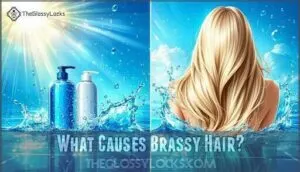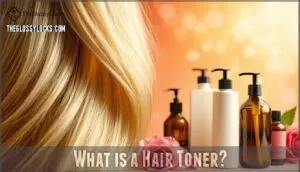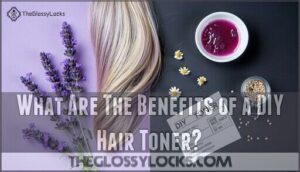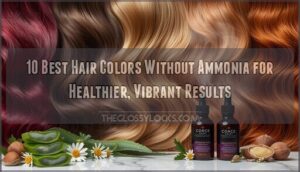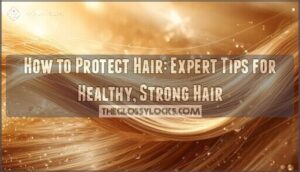This site is supported by our readers. We may earn a commission, at no cost to you, if you purchase through links.
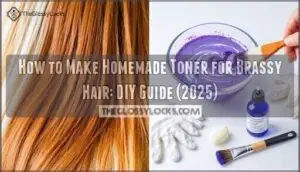
Here’s what actually works: mix violet food coloring or semi-permanent dye into white conditioner to make your own toner.
Purple cancels out yellow—it’s basic color wheel logic. When you apply it, the purple pigment bonds with those warm tones and neutralizes them.
A salon toning session? That’ll run you $80-150 every few weeks.
This DIY method costs maybe $8 total. And you’re in charge—no waiting for appointments, no letting someone else decide what goes on your head.
Mix it in three minutes, apply it when you want, and the results hold up just as well as the expensive stuff.
Table Of Contents
- Key Takeaways
- What is Brassy Hair?
- What Causes Brassy Hair?
- What is a Hair Toner?
- What Are The Benefits of a DIY Hair Toner?
- How Can You Prevent Brassiness From Affecting Your Look?
- How to Make Your DIY Hair Toner
- What Products Are Used for Homemade Toner for Brassy Hair?
- Frequently Asked Questions (FAQs)
- How often should I use a homemade toner for brassy hair?
- Does a DIY hair toner damage my hair?
- What is the best DIY toner for brassy hair?
- What is the difference between a blonde toner and a silver toner?
- How long should I leave the homemade toner on my hair?
- How long does homemade toner last in hair?
- Can you use DIY toner on dark hair?
- Whats the difference between toner and purple shampoo?
- How often should you reapply homemade hair toner?
- Does natural toner work on highlighted hair sections?
- Conclusion
Key Takeaways
- DIY purple toner costs under $2 compared to $63 salon visits and works through color theory—purple pigments sit opposite yellow on the color wheel, neutralizing brassy tones with up to 65% brass reduction after one or two applications. – Oxidation causes 80% of brassiness as blue pigment molecules fade first, while UV exposure, hard water minerals (affecting 85% of U.S. homes), and chlorine accelerate the color degradation process by breaking down melanin and stripping protective oils. – The homemade formula requires just white conditioner and 3-5 drops of violet semi-permanent dye, applied to damp hair for 30-60 minutes every 5-7 days to maintain cool tones without the ammonia or harsh chemicals found in commercial products. – Prevention strategies include weekly purple shampoo (63% warm tone reduction), shower filters (85% mineral deposit reduction), UV-protective sprays (26% sun damage reduction), and heat protectants (34% fewer orange undertones) to stop brassiness before it develops.
What is Brassy Hair?
Brassy hair shows up as those unwanted warm tones—think yellowy blondes or orangey browns—that crash your color party when you’re aiming for cool, clean hues. It’s what happens when your hair’s natural undertones stage a rebellion, showing up on roughly 73% of folks who lighten their hair or make that dramatic dark-to-blonde leap.
On brunettes, brassy tones flash orange or red. On blondes, you’ll see yellow taking center stage.
This hair color shift affects both color-treated and virgin hair—those warm undertones become more visible over time, demanding color correction through toner effects and brass prevention strategies to reclaim your desired look.
What Causes Brassy Hair?
Once you know what causes brassy hair, you can tackle it before it becomes a problem. Oxidation is the main culprit—about 80% of brassiness happens when pigment breaks down.
Blue molecules fade first, leaving those unwanted yellow and orange tones behind. Here’s what speeds up the process:
- Sun damage: UV rays break down melanin, spiking brassiness by 55% with regular exposure—your hair color fades 40% faster under direct sunlight.
- Hard water impact: With 85% of U.S. homes using hard water, mineral buildup from calcium, magnesium, and iron distorts color within five washes.
- Chlorine exposure: Pool chemicals strip natural oils and trigger chemical reactions, causing visible brassiness in 65% of swimmers with color-treated hair.
- Product residue: Sulfate shampoos and styling buildup strip 50% more pigment, while heat styling accelerates degradation in 46% of cases.
To minimize brassy tones, it’s vital to consider the environmental factors that contribute to color fading.
The key to fixing brassy hair? Know what you’re up against.
What is a Hair Toner?
Ever notice how blonde hair can turn brassy over time? That’s where toner comes in. It deposits cool pigments—usually purple or blue—that cancel out those unwanted yellow or orange tones in lightened hair.
Once you understand why purple toner works and what ingredients you’ll need, making your own is pretty straightforward.
Why a DIY Purple Toner Works
Here’s where the magic happens: purple pigment sits directly opposite yellow on the color wheel, making it your secret weapon for hair neutralization. When you apply a DIY hair toner with purple shampoo or dye, those violet molecules latch onto brassy tones and cancel them out—it’s pure color correction science.
Studies show up to 65% brass reduction after just one or two uses, which means you’re getting salon-level results without the salon price tag. You can tweak your toner formulas by adjusting pigment strength, giving you total control over how cool or warm your blonde goes. That’s the beauty of making your own—no oxidative damage, just smart chemistry working in your favor.
Understanding the benefits of purple shampoo guide is essential for achieving the best results with your DIY hair toner.
The Ingredients
So purple neutralizes yellow—color theory in action. Here’s what actually goes into the bottle:
- White conditioner (sulfate-free works best) – your base that carries pigments and protects natural oils
- Violet or blue semi-permanent dye – the color pigments that neutralize brass through pure color theory
- Optional boosters like apple cider vinegar or lemon juice hair toner for enhanced toning power
The conditioner is your vehicle, the plant dyes do the work, and you control the violet concentration—that’s where the power is.
What Are The Benefits of a DIY Hair Toner?
Making your own hair toner at home saves serious money. Salon toning costs around $63 each visit. A DIY version? Under $2. Over time, that’s a 90% saving just by mixing your own.
You’ll know exactly what touches your hair because you choose every ingredient, avoiding harsh chemicals like ammonia that strip hair health. The environmental impact shrinks dramatically when you skip single-use packaging and synthetic dyes that pollute waterways.
Customization options become limitless—adjust purple intensity for your exact shade, modify recipes for your hair type, and apply as often as needed without salon appointments. Scalp safety improves with food-grade ingredients that rarely trigger irritation compared to commercial formulas.
You’re in control now—no appointments, no guessing what’s in the bottle, just color maintenance on your terms.
How Can You Prevent Brassiness From Affecting Your Look?
Stopping brassy tones before they take over means building smart brass prevention habits into your routine. UV defense ranks first—sun exposure drives up to 60% of color fading in dyed hair, so wear hats or apply UV-protective sprays to shield your strands. Hard water creates mineral buildup that accelerates brassiness by 31%, making shower filters a breakthrough for color protection.
Here’s your action plan:
- Switch to purple shampoo weekly—it cuts warm tones by 63% within four washes
- Install a shower filter to reduce mineral deposits by 85%
- Use heat protectants before styling to limit orange undertones by 34%
- Apply leave-in UV sprays to cut sun-related fading by 26%
- Schedule salon touch-up sessions for 82% better brass control
Pair these hair maintenance strategies with your DIY hair toner applications, and you’ll keep brassy tones from stealing your look. This layered approach to color correction and preventing brassy hair through hair toning techniques delivers lasting results without constant salon trips.
How to Make Your DIY Hair Toner
Creating your own brass-busting toner takes just five minutes and transforms drugstore conditioner into a salon-quality color corrector. Here’s your blueprint for DIY hair toner mastery:
- Mix 3-5 drops of violet dye into white conditioner—adjust based on your hair porosity
- Apply directly to damp, towel-dried roots where brassiness strikes hardest
- Let it work for 30-60 minutes while the purple pigments neutralize yellow tones
- Rinse thoroughly without shampooing to lock in color correction
- Store leftover mixture in your shower for quick weekly maintenance
These toning techniques using natural ingredients deliver professional results without the salon price tag or chemical damage.
What Products Are Used for Homemade Toner for Brassy Hair?
Your toner is only as good as the products you choose—and the right purple dye can mean the difference between salon-worthy silver and disappointing lavender streaks. Professional-grade options like Manic Panic Ultra Violet or Pravana Vivids Silver deliver concentrated pigment that won’t fade after one wash. These purple products work because violet sits opposite yellow on the color wheel—your secret weapon for neutralizing brassy hair.
Pair your chosen dye with white conditioner as your base, creating color correctors that rival salon formulas. For maintenance between DIY hair toner treatments, rotate in toning shampoos or natural ingredients like apple cider vinegar rinses. Skip lemon juice hair toner if your hair’s already damaged—it strips moisture faster than it corrects color. Stock your arsenal smartly, and brassiness doesn’t stand a chance.
Frequently Asked Questions (FAQs)
How often should I use a homemade toner for brassy hair?
Think of toning frequency like tuning an instrument—overdoing it dulls the strings. Apply your DIY hair toner two to three times weekly for effective brass control without stripping moisture.
Hair porosity affects how quickly color fades, so adjust your toning schedule accordingly to maintain that cool, neutralized tone you’re after.
Does a DIY hair toner damage my hair?
DIY toner is way milder than what you’d get at a salon—no harsh oxidizers that fry your hair.
If you’re working with blonde or silver hair, purple shampoo formulas are a solid safe bet.
Just watch the acidic stuff like lemon juice. Use it too much and you’ll mess with your hair’s moisture and how porous it gets.
What is the best DIY toner for brassy hair?
The best DIY toner for brassy hair combines purple semi-permanent dye with white conditioner. This formula leverages color correction principles, where violet pigments neutralize yellow tones.
Apply it to damp hair, focusing on areas showing the most brassiness for targeted brass reduction.
What is the difference between a blonde toner and a silver toner?
Blonde toner counteracts yellow tones to keep your hair bright and shiny.
Silver toner goes deeper—neutralizing orange and yellow undertones to create cool, ashy platinum or gray shades that command attention.
How long should I leave the homemade toner on my hair?
Timing matters more than you think. Leave your hair toner on for 10-20 minutes, checking every few minutes until you hit your target shade.
Hair porosity affects application time—porous strands grab color faster, while healthy hair needs longer processing.
How long does homemade toner last in hair?
Homemade hair toner usually lasts three to five washes before warm tones creep back in.
Toner longevity depends on your hair porosity—porous hair loses color faster, requiring more frequent toner reapplication to maintain brass reduction and keep your look fresh.
Can you use DIY toner on dark hair?
DIY toner can work on dark hair, but don’t expect dramatic color correction.
Dark hair toning tackles orange or red brassiness using blue-toned formulas, while hair porosity determines how well your strands absorb the treatment for effective results.
Whats the difference between toner and purple shampoo?
Think of purple shampoo as maintenance between touch-ups—it gently deposits violet pigments to neutralize yellow tones with regular use.
Toner ingredients, whether blue toner for brassy hair or purple hair dye formulas, deliver stronger color correction by directly targeting hair porosity and underlying warm pigments during application.
How often should you reapply homemade hair toner?
Your hair maintenance schedule depends on how quickly brass creeps back—most need reapplication every five to seven days.
Track your color longevity and adjust your toning schedules accordingly.
Consistent hair care beats sporadic efforts when managing brassy hair with homemade hair toner recipes.
Does natural toner work on highlighted hair sections?
Yes—natural toner works on highlighted hair sections. Your highlights respond just like bleached hair, neutralizing those yellow or orange undertones with color correction methods.
Purple toner cancels brassy tones, bringing back cool, salon-fresh dimension to your hair care routine.
Conclusion
You don’t need a salon to fix brassy hair anymore. Once you understand how purple pigments neutralize orange tones, the rest is straightforward. Mix violet food coloring with white conditioner, apply it weekly, and those warm tones start disappearing.
It’s not complicated. You’ve got the formula, you know how to use it, and you’re not stuck with whatever a colorist decides looks good. Your hair, your rules.
You’ve got the formula, you know how to use it, and you control the outcome—not a salon colorist
- https://www.hairmnl.com/blogs/hair-education/the-brassy-culprit-what-s-causing-your-colored-hair-to-go-brassy
- https://www.lorealparisusa.com/beauty-magazine/hair-care/color-treated-hair/what-is-hair-toner
- https://diy.vitaminsrevive.com/diy-hair-toner/
- https://www.calmandchic.com/home/2017/9/12/keep-brassiness-at-bay-diy-botanical-blonde-hair-toner
- https://www.organicbeautyaward.com/articles/how-to-make-your-own-natural-hair-toner

